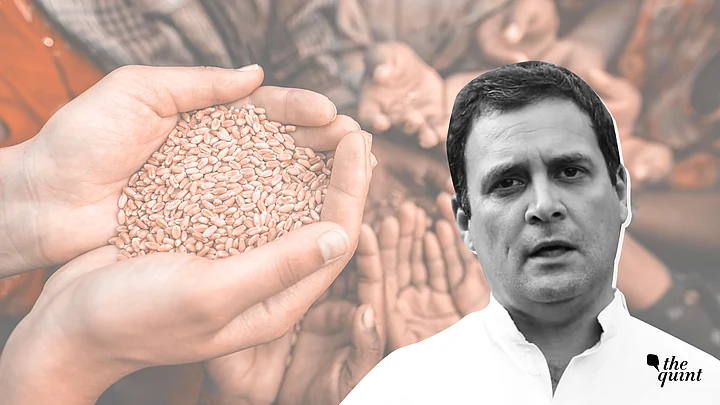Rahul Gandhi has pulled off an ‘Indira Gandhi’. His grandmother nationalised banks, abolished the privy purse and fought the 1971 elections on the Garibi Hatao platform. Rahul is fighting 2019 on the idea of a Minimum Income Guarantee aka NYAY. He has promised five crore poor families a minimum income of Rs 12,000 per month. That will work out to an average ‘top-up’ of Rs 6,000 per month or Rs 72,000 per year.
It will cost the government 3.6 lakh crore rupees per year. That is about 13 percent of what next year’s overall budget is estimated to be. It is more than half the estimated fiscal deficit.
If all other schemes stay and Rahul’s NYAY (Nyunatam Aay Yojana) comes over and above them, the fiscal deficit would rise to Rs 10.6 lakh crore in 2019-20. That’s about 5.1 percent of the estimated GDP for the next fiscal.
NYAY Could Result in Rise in Fiscal Deficit...
On the other hand, the food subsidy could get subsumed under NYAY. That’s estimated to be Rs 1.84 lakh crore in 2018-19. Some of the income guarantee could also be in the form of wages under MGNREGA, which has an outlay of Rs 60,000 crores.
Too busy to read? Listen to this instead.
If the two are added, it works out to a little more than 2/3rd of the proposed expenditure on Rahul Gandhi’s income top-up scheme. In that case, he will have to spend another Rs 1.2 lakh crore. The fiscal deficit would increase to Rs 8.2 lakh crore or 4 percent of the GDP.
So, implementing NYAY could result in the fiscal deficit rising from the current 3.4 percent to anywhere between 4 percent and 5.1 percent, depending on how much extra has to be spent on it.
Fiscal fundamentalists will tell you that this will be disastrous, as it will push up interest rates and prices. But, is that really true?
...But Is That Disastrous?
Imagine a cement factory that uses a machine worth Rs 10 crore. If the machine has a life of 5 years, it costs the cement company Rs 2 crore annually, to run it. Now, imagine that the machine can churn out 10,000 bags of cement per year, but because there isn’t enough demand, the company produces only 5,000 bags. At full capacity, the average machine-cost would have worked out to Rs 2,000 per bag. But, at 50 percent capacity utilization, the average fixed cost works out to Rs 4,000 per bag.
Now, imagine that the government transfers cash into the hands of people who were too poor to buy cement. The effective demand for cement goes up. The factory can now produce more cement, pushing down the machine-cost per bag. In this case, higher demand has done the exact opposite of what textbook economics would tell you: instead of raising prices, it has actually brought them down.
That is precisely the problem the Indian industry is facing right now. Consumers do not have enough money to buy what India Inc produces, therefore, our factories are operating at less than 75 percent capacity. In cement, it’s even lower, at about 70 percent. In the auto sector, things are looking worse. India’s largest car maker Maruti Suzuki Limited has cut output by 8 percent this month. NYAY could change that.
NYAY’s ‘Multiplier Effect’
If Rs 3.6 lakh crore is injected into the economy to stimulate demand, it will have a multiplier effect across the economy. The poor will buy more food, milk, medicines, torches, batteries, clothes, phones and other things that are currently just out of their reach. They might spend more on repairing their homes, buying cement, low-end paints and tiles. They’ll probably spend more on their children’s education, sending them to the local ‘English-medium’ school.
This will initially lead to a demand spurt for companies that produce goods consumed by the poor, such as FMCG, battery manufacturers, seed companies, cement majors. They in turn will hire more people, buy more raw materials and machines, spend more on advertising.
Those employed will spend on goods and services, take loans to buy cars and homes, and also invest a part of their income. Real estate and auto sectors will revive, and the financial sector will gain as money flows into the markets and banks do more business. And given that these sectors are currently operating at lower than optimum capacities, prices could even fall instead of rising.
What If Food-Subsidy & MGNREGA Were Subsumed Under NYAY?
The overall multiplier effect of NYAY could well result in double digit real GDP growth. If inflation rises to 5 percent and real GDP grows at 10 percent, the nominal GDP would rise to Rs 217 lakh crore instead of the Rs 210 lakh crore estimated for the next fiscal. At the same tax/GDP ratio, the government’s tax receipts would also go up by over Rs 53,000 crore.
If that happens, the additional burden of NYAY would result in a fiscal deficit of 4.6 percent if the entire scheme were to be financed with additional funds.
If the current food-subsidy and MGNREGA were to be subsumed under this scheme, the fiscal deficit will work out to 3.5 percent of the GDP. Compare that to the current 3.4 percent, and you will see that NYAY is not only feasible, it is absolutely essential.
(Aunindyo Chakravarty was Senior Managing Editor of NDTV's Hindi and Business news channels. He now anchors Simple Samachar on NDTV India. He tweets @AunindyoC. This is an opinion piece. The views expressed above are the author’s own. The Quint neither endorses nor is responsible for them.)
